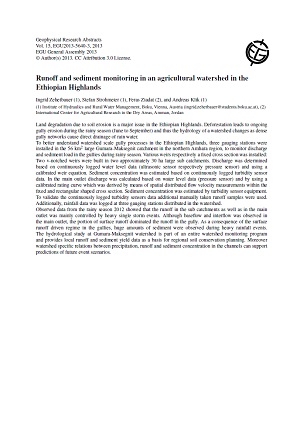Resource information
Land degradation due to soil erosion is a major issue in the Ethiopian Highlands. Deforestation leads to ongoing gully erosion during the rainy season (June to September) and thus the hydrology of a watershed changes as dense gully networks cause direct drainage of rain water. To better understand watershed scale gully processes in the Ethiopian Highlands, three gauging stations were installed in the 56 km2 large Gumara-Maksegnit catchment in the northern Amhara region, to monitor discharge and sediment load in the gullies during rainy season. Various weirs respectively a fixed cross section was installed: Two v-notched weirs were built in two approximately 30 ha large sub catchments. Discharge was determined based on continuously logged water level data (ultrasonic sensor respectively pressure sensor) and using a calibrated weir equation. Sediment concentration was estimated based on continuously logged turbidity sensor data. In the main outlet discharge was calculated based on water level data (pressure sensor) and by using a calibrated rating curve which was derived by means of spatial distributed flow velocity measurements within the fixed and rectangular shaped cross section. Sediment concentration was estimated by turbidity sensor equipment. To validate the continuously logged turbidity sensors data additional manually taken runoff samples were used. Additionally, rainfall data was logged at three gauging stations distributed in the watershed. Observed data from the rainy season 2012 showed that the runoff in the sub catchments as well as in the main outlet was mainly controlled by heavy single storm events. Although baseflow and interflow was observed in the main outlet, the portion of surface runoff dominated the runoff in the gully. As a consequence of the surface runoff driven regime in the gullies, huge amounts of sediment were observed during heavy rainfall events.
The hydrological study at Gumara-Maksegnit watershed is part of an entire watershed monitoring program
and provides local runoff and sediment yield data as a basis for regional soil conservation planning. Moreover watershed specific relations between precipitation, runoff and sediment concentration in the channels can support predictions of future event scenarios.


